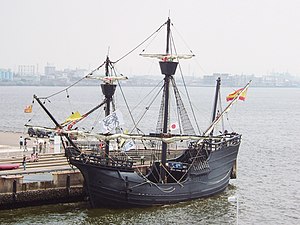Victoria (ship)

|
|
| History | |
|---|---|
|
|
|
| Name: | Victoria |
| Namesake: | Santa Maria de la Victoria |
| Owner: | Ferdinand Magellan/Sebastian Elcano |
| Ordered: | 1518 |
| Launched: | 1519 |
| Fate: | Disappeared en route to Seville from the Antilles, 1570 |
| Notes: | First ship to circumnavigate the globe. |
| General characteristics | |
| Class and type: | Carrack |
| Tonnage: | 85 |
| Length: | 18 to 21 metres (59 to 69 ft) |
| Complement: | 55 |
Victoria (or Nao Victoria, as well as Vittoria) was a Spanish carrack and the first ship to successfully circumnavigate the world. Victoria was part of a Spanish expedition commanded by the Portuguese explorer Ferdinand Magellan, and after his death during the voyage, by Juan Sebastián Elcano. The expedition began on August 10, 1519 with five ships but Victoria was the only ship to complete the voyage, returning on September 6, 1522. Magellan was killed in the Philippines. The ship was built at a shipyard in Gipuzkoa, with the Basques being reputed shipbuilders at the time, and along with the four other ships, she was given to Magellan by King Charles I of Spain (The Holy Roman Emperor Charles V). Victoria was named after the church of Santa Maria de la Victoria de Triana, where Magellan took an oath of allegiance to Charles V.Victoria was an 85 ton ship with a crew of 42.
The four other ships were Trinidad (110 tons, crew 55), San Antonio (120 tons, crew 60), Concepcion (90 tons, crew 45), and Santiago (75 tons, crew 32). Trinidad, Magellan's flagship, Concepcion, and Santiago were wrecked or scuttled; San Antonio deserted the expedition during the navigation of the Straits of Magellan and returned to Europe on her own.
Victoria was rated a carrack or nao (ship), as were all the others except Santiago, which was a caravel.
The voyage started with a crew of about 265 men aboard five ships. Of all these, only 18 men returned alive on Victoria. Many of the men died of malnutrition. Beginning the voyage, Luis De Mendoza was her captain. On April 2, 1520, after establishing a settlement they called Puerto San Julian, in Patagonia a fierce mutiny involving three captains broke out, but it was ultimately quelled.Antonio Pigafetta's and other reports state that Luis de Mendoza and Gaspar Quesada, captain of Concepcion were executed and the remains hung on gallows on the shore.Juan de Cartagena, captain of San Antonio was marooned on the coast. Duarte Barbosa, a Portuguese who had sided with Magellan in facing the mutiny, then became the captain of Victoria. According to Pigafetta, after Magellan's death on April 27, 1521, at the Battle of Mactan, remnants of the fleet tried to retrieve Magellan's body without success. Thereafter, Duarte Barbosa and João Serrão were elected leaders of the expedition. On May 1, 1521 they were invited by rajah Humabon of Cebu, of the Philippines to a banquet ashore to receive a gift for the king of Spain. There most were killed or poisoned, including Duarte Barbosa and João Serrão, who was brought by natives who wanted to exchange him for weapons, but was left behind. Pilot João Carvalho, who had survived the trap, then became the captain of Victoria. In August, near Borneo he was deposed and Juan Sebastián Elcano became captain for the remainder of the expedition.
...
Wikipedia
